The great thing about working freelance is that I get to choose my projects. And I’m so happy I got to do this series on financial literacy for kids for Liwayway Marketing Corporation (LMC), makers of Oishi snacks. And, it was as if the forces of the Universe were conspiring, because, the very next day, I got another e-mail from my publisher, Ani Almario of Adarna House, asking if I would be interested to write a series of books on the very same topic for their client, Insular Life. Needless to say, this incredible coincidence had put me in a quandary; do I say yes to one and turn down the other? And if it I were to decide based on a first-come, first-served basis, did that mean saying yes to Liwayway who was, after all, the one who contacted me first, and no to Adarna who contacted me the next day? Or keep mum, ask for a brief from both clients to know more about the projects, and then choose which was more interesting?
But the thing was, both projects seemed interesting. Apart from Francisco Colayco and Nina Lim Yuson’s “Money for Kids (Pera Mo, Palaguin Mo)”, there didn’t seem to be any books on financial literacy for Filipino kids. And both clients were favorites of mine. LMC has been my client since 2003. I wrote copy and designed packaging, billboards and a trade exhibit for them. My relationship with Adarna House goes even farther back to 1995 when I published my very first children’s book. It was a tough one to decide. And so I wrote back both clients, telling them how I would love to work on their project and at the same time, informing them about my dilemma, without disclosing which parties were involved. I prepared for the worst possible scenario, which was to lose both clients, and waited.
And then, happily, I got both projects! Both clients told me that they appreciated my confidence, and for as long as the other party didn’t mind, then they would be happy to work with me. Even if they didn’t ask for it, I reassured both that I will make the two series very distinct in terms of style and treatment. It also helped that LMC wanted a younger audience, the early reader, and Insular Life/Adarna wanted the middle readers. More on the Insular Life/Adarna book series in another post.
To prepare for both projects (I had to work on both simultaneously, because of the deadlines, and, more importantly, because I wanted to draw up distinct frameworks for each series, I had to read up on local and foreign resources on financial management concepts, including but not limited to materials addressed to children. My client C from LMC showed me some beautiful picture books, FDIC chair Shiela Bair‘s “Isabel’s Car Wash” and “Rock, Brock and the Savings Shock”.
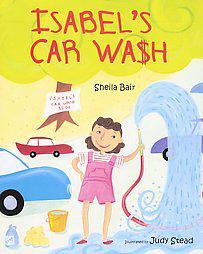
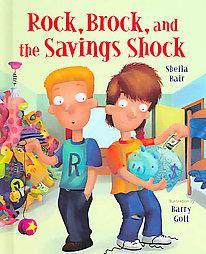
“That’s one of the reasons I wanted to write picture books for children because the parents read the picture books with their kids, so the parents can maybe pick up some information too as they’re reading the book with their child.”–Shiela Bair
C was pretty definite with what he wanted to do with the Oishi series. He wanted a wide readership that included the preschooler whose mother will read it to him, as well as the adult who needs advice in managing his retirement funds. But first, we decided we had to call the series something. We brainstormed (and this would be characteristic with my working relationship with C throughout the writing of the series–a very close collaboration, with C acting as my co-writer and editor) and came up with Oishi Peso Smart Kids.
As for style, C and I agreed that a cautionary tale which would give the child a vicarious experience and which would be metaphorical as well and have an ambivalence adults can relate with.
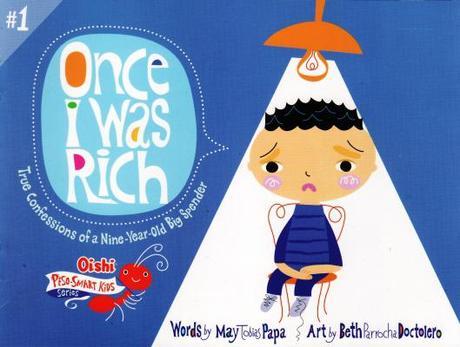
ONCE I WAS RICH (©2009) In the first book, “Once I Was Rich: True Confessions of a Nine-Year-Old Big Spender”, the little boy in the story gets a thousand pesos for his birthday and blows it all away in no time. This book tackles how thoughtless spending is like an addiction which, when left unchecked, can lead to disastrous results. Mindfulness is key when spending, so that you will be able to manage your funds better.
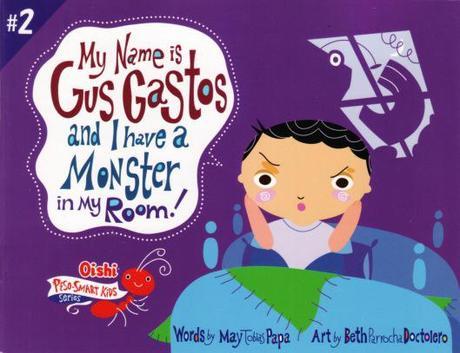
MY NAME IS GUS GASTOS AND THERE’S A MONSTER IN MY ROOM (©2010) The second book is a bit autobiographical for me. Thoughtless accumulation of objects leads to clutter in the house. Sometimes you accumulate so much clutter that it’s impossible for you to find things, so you buy new things to replace the things you’d lost, and the vicious cycle continues. And because you had accumulated so much stuff, most of them unused, you fall into lethargy and refuse to take decisive steps to deal with the problem (which continually worsens). And the problem is literally (and visually) turned into a monster.
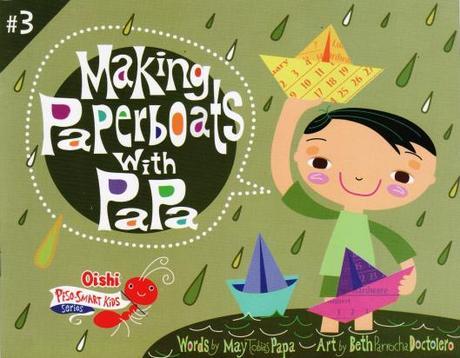
MAKING PAPERBOATS WITH PAPA (©2010) The thing with making a story for a series is that you have to constantly check whether it fits–is it still within the topic of financial literacy, and more importantly, what does it contribute to the topic? will the storytelling be consistent with the previous ones? C and I have pitched to each other, and similarly, have shot down numerous story ideas before we wrote these three books (and a fourth one, which is still on the drawing board) for the Oishi Peso Smart Kids series. The tough part is how to do this and not be boring.
For the third book, C told me wanted a story about Ondoy. He told me of the story of his friend and his profound lesson from the flood, that against Nature you really are powerless, and so it’s best to live with zen habits, with only things that are most essential. I had my own personal experience to add to this third book. Ondoy had submerged our house in thigh-high flood. The water rose so fast that we only had enough time to pull out drawers from my parents’ bedroom cabinets–drawers that contained precious family documents and family photographs–and take them up to the second floor. Except for food and drinking water, my husband, sister-in-law and myself took very little else upstairs, because we had resigned to the fact that we won’t be able to save much anyway. Luckily we didn’t lose electricity the whole day, although we had voluntarily shut down the power for most of the time to avoid being electrocuted (because water had seeped into the electrical sockets), and during these times we had electricity I was able to read the updates on my friend’s FB walls, and one that particularly got my attention was the update on my friend (also illustrator for the Oishi Peso Smart Books series) Beth Parrocha Doctolero who said that their area was flooded, and then, much later, that she had made paper boats with her son. I said, how wonderful, to see beauty in the midst of a calamity. I had always envied Beth’s coolness, and had not envied her so much as I did then; I was near-hysterical with horrific imaginings of the tsunami at Banda Aceh. I was so scared for my son who was only three then. I only wished I had the same calmness as Beth had. It was all these that went into the 650-word storybook that is now “Making Paperboats with Papa.”
The Oishi Peso Smart Books is not available at your favorite bookstores, but you can read “Once I Was Rich” and “Gus Gastos” online for free, in English or Filipino here. The books are illustrated by the incredible Beth Parrocha Doctolero.
